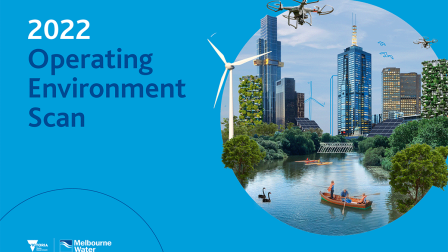Our annual Operating Environment Scan helps us identify global changes, or ‘trends’, that present emerging obstacles and opportunities for our business and broader industry.
The Scan is a key input to our strategic and business planning process, provoking thought and discussion to help determine strategic priorities then delivered through our Corporate and Business plans. It aims to support creative strategic explorations of the possible futures that lay ahead – and most importantly, to catalyse action today.
We cannot know what the world will look like in 10 years, but we know this will be the decade that matters: when the actions we take in the next few years can secure a better future for generations to come.
Download the report
We’ve made the Scan available to our customers and stakeholders in the spirit of knowledge sharing. We encourage you to consider the impact of these trends when planning your work, to help prepare the water industry for the future.

Key drivers of change
The following 12 drivers are identified as having meaningful implications for Melbourne Water’s strategic position or business performance, should there be any change in their directionality, quality or magnitude.
- Population
-
Population growth within the Greater Melbourne service area has been one of the most important drivers of change for Melbourne Water. Increased urbanisation in Melbourne, resulting from population growth, places stress on existing infrastructure and provides the impetus for infrastructure network upgrades and expansion.
Key changes:
- Population growth and the COVID-19 pandemic slowdown
- Climate-driven migration
- Ageing population and declining fertility
- Energy supply
-
Water utilities are energy-intensive businesses. The delivery of water and related services involves transportation, treatment, distribution, and disposal of water and sewerage. These processes depend on high volumes of energy inputs. There is also a significant amount of embedded energy within the materials used within the infrastructure networks and consumables we rely upon.
Key changes:
- Strengthened energy transition ambitions
- Improvements in renewable energy technologies
- Energy scarcity and volatility
- The road to net zero emissions threatened
- Water resources and use
-
Raw water resources, whether from catchment, desalinated or other sources, are a critical input for Melbourne Water’s business. As water resources are not easily transportable, we are reliant on adequate and available supply of raw water resources from within or near to our service area. Accordingly, Melbourne Water and its services have a high degree of climate sensitivity.
Key changes:
- Growing water scarcity
- Increased demand for water
- Returning water to Traditional Owners
- Growth in use of recycled water
- Increased private investment in water
- Skilled labour
-
Like all businesses, Melbourne Water depends fundamentally on its people. As a water utility, a significant proportion of our workforce comprises technical specialists, proficient at planning for, designing, constructing, operating, and maintaining water and related infrastructure. Melbourne Water also requires a contingent of skilled workers to maintain the corporate and administrative infrastructure of the organisation that supports service delivery, including information technology and digital specialists, customer service representatives, human resources and communications, financial specialists, and corporate planning and reporting.
Key changes:
- Changing needs of an older workforce
- Women and equality continue to be a focus
- Labour shortages increasing
- Worker burnout, resistance and resignation
- Employee experience becoming a battleground
- Financial resources and economy
-
Melbourne Water’s service delivery is constrained largely by the revenue it is permitted to collect from customers by the Essential Services Commission (ESC), a price that is determined through the five-yearly Price Submission process and based on the estimated cost to operate in accordance with customer and community requirements and expectations of our services and their price. In addition, with the Victorian Government as our sole shareholder, Treasury also seeks a variable annual dividend from Melbourne Water, which varies according to the State Budget.
Key changes:
- Global economic slowdown
- Economic flux in Australia
- Affordability concerns
- Increasing private investment in water
- Customer and community expectations
-
Melbourne Water’s services are largely determined through engagement with customers and the community in a five-yearly Price Submission process regulated by ESC. Expected service outcomes and funding for service delivery are determined by the outcomes of this process, and Melbourne Water is held to account on delivery against these customer expectations. Further, as an essential service provider, Melbourne Water recognises the social contract it holds with the wider public to deliver its services in alignment with evolving public expectations, particularly as it relates to environmental, social and governance responsibilities.
Key changes:
- Consumers are becoming more conscientious
- The digital customer experience
- Supply chain
-
Melbourne Water is the custodian of large-scale infrastructure networks and facilities that are critical for our service delivery. Our ability to maintain the condition, reliability, and continuity of this infrastructure depends, in part, on our ability to procure adequate supplies of materials, including pipes, pumps, and parts, as well as chemical inputs used for treatment processes. Like many other businesses, Melbourne Water is also increasingly reliant on digital infrastructure.
Key changes:
- Global shocks revealing supply chain vulnerabilities
- Supply chain disruption
- Shift in focus from efficiency to resilience
- Availability of critical supplies
- Increasing digitisation of procurement
- Transition toward resilient circularity
- Natural and man-made disasters
-
Infrastructure networks can be damaged or disabled by natural and man-made disasters, impacting service continuity and quality, with potentially significant consequences for human health. Although natural and man-made disasters have always been a part of the operating environment for water utilities, phenomena such as climate change and the rapid digitisation of society are compounding these challenges, making them more likely to occur at higher frequency and magnitude.
Key changes:
- Incidence of extreme weather events
- Climate change tipping points
- Increasing incident of cyberattacks
- Continued threat of terrorism
- The war in Ukraine
- Potential for conflict between the US and China
- Threat of global collapse
- Enterprise technology
-
The technological systems and processes adopted by an organisation provide critical support to the delivery of its core services. The nature of these systems, particularly whether they are fit for purpose, have a significant impact on the performance of the organisation and its employees in delivering appropriate service levels.
Key changes:
- Advancements in artificial intelligence and machine learning
- Internet of Things (IoT) and 5G
- Extended reality is becoming part of the toolkit
- Increasing importance of cyber security
- Rise of new technology roles
- Technology creating new challenges and opportunities
- Rise in workplace surveillance
- Water technology
-
Technology is continually evolving, and new water-specific technological innovations are emerging all the time. The water technology systems and processes adopted by a utility are critically important to service delivery, affecting service performance, operational efficiency, the cost-to-serve, robustness and resilience, and what human skills are needed for their maintenance.
Key changes:
- Better ways of making and harvesting water
- The advancement of smart systems to manage water
- Use of digital twins in the water sector
- Shift to decentralised solutions
- Regulation and policy direction
-
As a water corporation operating in Victoria, Melbourne Water is afforded the mandate to operate under Victorian Government legislation and is beholden to a range of legislative and regulatory requirements. Melbourne Water is also a policy delivery arm of the Victorian Government and is obligated to implement policy aims where directed.
Key changes:
- Policy around climate change and environment-related issues
- Carbon emissions labelling of goods and services
- Standardisation of critical infrastructure and cyber security
- Justice and self-determination for Traditional Owners
- Catchment health
-
Victoria’s catchments are rich in environmental, economic, and cultural value. As vibrant hubs for biodiversity and natural assets, the five distinct but interconnected and interdependent major catchment systems within the Port Phillip and Western Port region are home to some of Victoria’s most iconic species and the major source of raw water that Melbourne Water harvests to treat and provide to its customers. Water quality is affected significantly by the health and integrity of the catchment, which functions as the front-line filter and storage for raw water resources. Many of our primary catchments are protected for this reason, but their protection must always be balanced against competing interests.
Key changes:
- Continuing environmental degradation
- Climate change impacting catchment health
- Increasing urbanisation pressures
- Emerging contaminants
- Negative impacts of agriculture and farming
- Citizen-led action groups paving the way forward



